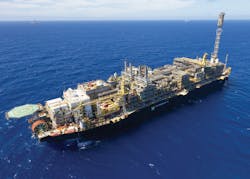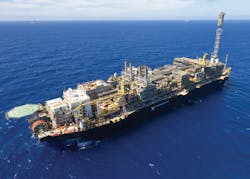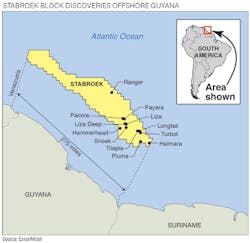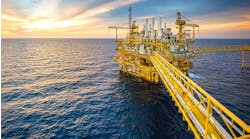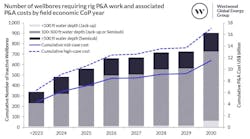Guyana, Brazil leading the way
Jessica Stump, Assistant Editor
Operators haveramped up exploration and production activities across Latin America. The region’s offshore plays will account for one-third of the large prospects due to be drilled globally this year, according to analyst Wood Mackenzie. Potentially giant reservoirs offshore Brazil, Guyana, and Mexico will attract the highest investment.
Dr. Andrew Latham, vice president, Global Exploration at Wood Mackenzie, said: “We expect billion-barrel scale volumes from these emerging and newly-proven plays, as has been the case in the last couple of years.”
The Stabroek block offshore Guyana continues to deliver for Exxon Mobil Corp. and its partners Hess Corp. and CNOOC Ltd. Earlier this year, the partners made two more deepwater discoveries on the 10,348-sq mi (26,800-sq km) block, bringing the total number to 12 and thegross recoverable resource estimate to about 5.5 Bboe.
The Tilapia-1 well is the fourth discovery in the Turbot area that includes the Turbot, Longtail, and Pluma discoveries. Tilapia-1 encountered about 305 ft (93 m) of high-quality oil-bearing sandstone reservoir and was drilled by the drillship Noble Tom Madden to a depth of 18,786 ft (5,726 m) in 5,850 ft (1,783 m) of water. The well is about 3.4 mi (5.5 km) west of the Longtail-1 well.
The P-74 was the first FPSO installed over the Búzios field in the presalt Santos basin. (Courtesy Petrobras)
“We see a lot of development potential in the Turbot area and continue to prioritize exploration of high-potential prospects here,” said Steve Greenlee, president of ExxonMobil Exploration Co. “We expect this area to progress to a major development hub providing substantial value to Guyana, our partners, and ExxonMobil.”
The other discovery was at the Haimara-1 well, which encountered about 207 ft (63 m) of high-quality, gas-condensate bearing sandstone reservoir. The well was drilled by the drillship Stena Carron to a depth of 18,289 ft (5,575 m) in 4,590 ft (1,399 m) of water. It is about 19 mi (31 km) east of the Pluma-1 discovery and is a potential new area for development.
ExxonMobil affiliate Esso Exploration and Production Guyana Ltd. is the operator and holds 45% interest in the block, Hess Guyana Exploration Ltd. holds 30% interest, and CNOOC Petroleum Guyana Ltd. holds 25% interest.
According to ExxonMobil, there is potential for at least five FPSOs on the Stabroek block producing more than 750,000 b/d of oil by 2025. The Liza Phase 1 development is progressing on schedule and is expected to begin producing up to 120,000 b/d of oil in early 1Q 2020, using the FPSO Liza Destiny. This summer the FPSO is due to depart Keppel Shipyard in Singapore and arrive in Guyana in 3Q.
Liza Phase 1 is about 118 mi (190 km) offshore in water depths of 4,921-6,234 ft (1,500-1,900 m). Pending government and regulatory approvals, ExxonMobil expected to sanction Liza Phase 2 in 1Q 2019. This phase will use a second FPSO, with start-up targeted in 2022. The company has contracted SBM Offshore to perform front-end engineering and design (FEED) for the FPSO. The second Liza FPSO design is based on SBM’s Fast4Ward concept, a newbuild, multi-purpose hull combined with various standardized topsides modules. It will be designed to produce 220,000 b/d of oil with associated gas treatment capacity of 400 MMcf/d and water injection of 250,000 b/d. It will be spread moored in a water depth of around 5,249 ft (1,600 m) and will be able to store around 2 MMbbl of crude oil.
Latin America | |
Reserves | |
Remaining Reserves (Million bbl) | 143,918 |
Production | |
Current Production levels | 4,387 |
Liquids (kbbl/d) | 3,087 |
Gas (kbbl/d) | 1,300 |
Production platforms | |
# Producing fields Total | 187 |
# Tie backs | 28 |
# Floating production | 47 |
# Fixed production | 112 |
Drilling Rigs | |
# Floaters Demand 2019 | 24 |
# Jackups Demand 2019 | 5 |
Infrastrcture | |
# Active Wells | 4,268 |
# Active XMTs | 1,163 |
# Installed XMTs (2019) | 46 |
Active SURF lines (km) | 12,178 |
Field sanctioning 2019-2021 | |
# Fields to be sanctioned | 33 |
Subsea tie back | 10 |
Floater | 19 |
Fixed | 4 |
Oilfield Service Purchases 2019 (MUSD) | |
Maintenance and Operations | 11,122 |
Well Services and Commodities | 1,974 |
Drilling Contractors | 2,369 |
Subsea | 3,608 |
EPCI | 4,639 |
Seismic | 640 |
Source: Rystad Energy UCube, DCube, WellCube | |
TechnipFMC won the contract to engineer the subsea system, which is expected to include 30 enhanced vertical deepwater trees and associated tooling, as well as eight manifolds and associated controls and tie-in equipment. ExxonMobil has contracted Saipem to perform detailed engineering, procurement, construction, and installation of the risers, flowlines, and associated structures and jumpers, and will also transport and install umbilicals, manifolds, and associated foundations for the production, and water and gas injection systems.
Sanctioning of a third development, Payara, is also expected in 2019, and startup is expected as early as 2023 through a 180,000-b/d capacity FPSO.
In 2018, Petrobras brought four new production systems online: the FPSOs P-74 and P-75 over the Búzios field in the presalt Santos basin; the FPSO P-69 at the Lula field in the same sector; and the FPSO Cidade de Campos dos Goytacazes over the Tartaruga Verde field in the post-salt Campos basin.
So far this year, Petrobras has brought online the P-76 and P-77, the third and fourth FPSOs installed over the Búzios field, as well as the FPSO P-67 in the Lula Norte area of the presalt Santos basin. According to company, the Lula field, covering the Lula and Cernambi reservoirs, is now the largest producer in Brazil and should eventually deliver 1 MMb/d this year. Commercial production started in October 2010.
As for the Mero 1 project in the presalt Santos basin, Petrobras has contracted Aker Solutions to provide a subsea production system and associated services. The equipment will comprise 12 vertical subsea trees tailored to Brazil’s presalt, four subsea distribution units, three topsides master control stations for the FPSO, and spare parts. In addition, Aker Solutions will provide installation and commissioning support services. Equipment deliveries are scheduled for 2020, with installations spread between 2020 and 2023.
The subsea production system will be hooked up to the FPSO Guanabara MV31, which is due to come onstream in 2021. MODEC is constructing the FPSO which is expected to have the capacity to process up to 180,000 b/d of oil and 12 MMcm/d of gas. TechnipFMC is responsible for all rigid lines and the infield riser and flowline system for interconnecting 13 wells (six producers and seven water alternate gas injectors) to the FPSO. It will also install rigid pipelines (including corrosion-resistant alloy and steel lazy wave risers), flexible risers and flowlines, steel tube umbilicals, and other subsea equipment.
Mero is in the northwestern part of the Libra block, 112 mi (180 km) south of Rio de Janeiro. A modified FPSO, the Pioneiro de Libra, produced first oil from the field in November 2017, under an extended test program. During the tests, the production well delivered 58,000 boe/d, which the company described as “a great result in ultra-deepwaters.” The other aims, all achieved, were to obtain high-quality data and reduce uncertainties over the reservoir, to allow accelerated deployment of up to four full-scale production systems on Libra in the next few years, each capable of producing up to 180,000 b/d of oil.
Petrobras’ partners in the Libra area are Shell, Total, CNPC, and CNOOC, with Pre-Sal Petróleo managing the production-sharing contract.
Offshore Mexico, Talos Energy has contracted McDermott to provide concept and engineering services for the Zama field development in block 7 of the Sureste basin. The scope includes concept selection and follow-on pre-front-end engineering design. McDermott will execute the program with io oil & gas consulting, the company’s joint venture with Baker Hughes, a GE company. Conceptual selection work has started and should be completed this summer.
Discovered in July 2017 in in a water depth of about 540 ft (165 m), Zama was the first exploration well drilled offshore Mexico by a private sector operator. Talos estimates recoverable resources at 400-800 MMboe.
Talos is the operator of block 7 with 35% participating interest. Its partners are Premier Oil (25% participating interest) and Sierra Oil & Gas (40% participating interest). They are targeting final investment decision in 2020 and first oil in 2022.
The semisubmersible Ensco 8503 is currently conducting the Zama discovery appraisal program, which consists of three reservoir penetrations, including two wells and one side track.
Late last year, Eni took the final investment decision to proceed with the $2-billion Area 1 development, which will feature an initial early production phase. This is due to start up in mid-2019 through a wellhead platform on the Miztón field, with production heading onshore through a 10-in. multi-phase line followed by treatment at an existing Pemex facility. Eni anticipates an early production plateau of 8,000 b/d; and full-field production is expected to start in early 2021 through an FPSO with a treatment capacity of 90,000 b/d. Two more platforms will be installed on the Amoca and Tecoalli fields. Area 1, located in the shallow waters of the Campeche Bay, is estimated to hold 2.1 Bboe in place (90% oil) in the Amoca, Miztón, and Tecoalli fields. According to the company, Area 1 oil output will eventually total 90,000 b/d and 65 MMcf/d from 2021.
In February, BP Trinidad and Tobago (BPTT) produced first gas from the Angelin development. Originally discovered by the El Diablo well in 1995, the field is 37 mi (60 km) off the southeast coast of Trinidad in a water depth of about 213 ft (65 m). Angelin includes four wells and a new platform with a production capacity of 600 MMscf/d. Gas flows from the platform to the existing Serrette hub via a new 13-mi (21-km) pipeline. This is the company’s first major project development supported by the application of ocean bottom cable seismic acquisition with advanced processing, allowing enhanced imaging of its reservoirs in the Columbus basin.
In 2018, BPTT sanctioned the Cassia Compression and Matapal gas developments, which are expected to come onstream in 2021 and 2022, respectively.
The Cassia Compression project will involve the construction of a new platform, Cassia C, the company’s 16th installation offshore Trinidad. The platform, located 35 mi (57 km) offshore southeast Trinidad, will have a throughput capacity of 1.2 bscf/d of gas. Gas production from the Greater Cassia Area will be routed to Cassia C for compression before being exported via the adjacent existing Cassia B platform. First gas from the facility is expected in 3Q 2021.
Under an EPC contract, McDermott will provide engineering, procurement, construction, hook-up, and commissioning of the 8,928-ton (8,100-metric ton) Cassia C topsides, a 3,747-ton (3,400-metric ton) jacket, and a 793-ton (720-metric ton) bridge to link Cassia C with the existing Cassia B platform that currently sits in 223 ft (68 m) of water. The scope also includes brownfield modifications at Cassia B.
The compression platform will be fabricated and constructed at McDermott’s fabrication facility in Altamira, Mexico. Trinidad Offshore Fabrication Co. will fabricate the jacket and the bridge landing frame.
The Matapal project will develop the gas resources discovered with the Savannah exploration well in 2017. The project will be a three-well subsea tieback to the existing Juniper platform. First gas from Matapal is expected in 2022.
